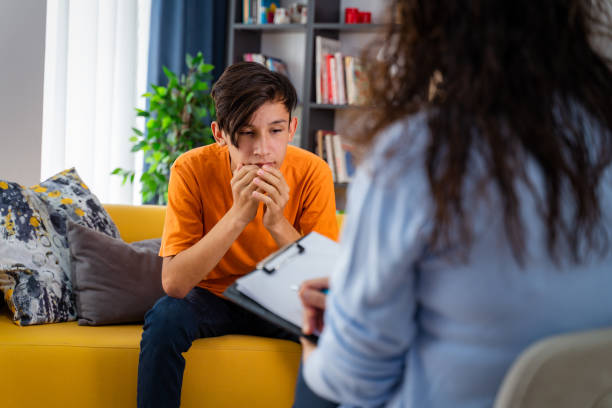Teen anxiety affects many adolescents and can interfere with school, friendships, and family life. Finding the right treatment matters because not all approaches work the same for everyone. Cognitive Behavioral Therapy (CBT) stands out as the most effective therapy for teen anxiety, helping adolescents identify negative thought patterns and replace them with healthier coping strategies.
Other therapies also show strong benefits depending on individual needs. Dialectical Behavior Therapy (DBT) can support teens who struggle with intense emotions, while exposure therapy helps those facing specific fears. Mindfulness practices, family therapy, and creative approaches like art therapy provide additional tools that strengthen overall mental health. By understanding which therapies offer the most proven results and how supportive methods can complement them, families can make informed decisions. The right combination of approaches can give teens the skills they need to manage anxiety and build long-term resilience.
Key Takeaways
- Teen anxiety requires effective and tailored treatment approaches
- CBT and other evidence-based therapies provide the strongest results
- Supportive methods can enhance progress and build resilience
Most Effective Types of Therapy for Teen Anxiety
Effective treatment for teen anxiety often focuses on identifying unhelpful thought patterns, gradually reducing fear responses, and building stronger emotional regulation skills. Approaches vary, but the most widely supported methods emphasize structured coping strategies, present-moment awareness, and practical tools that teens can use in daily life.
Cognitive Behavioral Therapy (CBT)
Cognitive Behavioral Therapy (CBT) is one of the most researched and recommended approaches for teen anxiety. It teaches adolescents how to recognize cognitive distortions such as all-or-nothing thinking or overgeneralization, which often fuel anxiety symptoms. By learning to challenge these negative thought patterns, teens can replace them with more balanced and realistic perspectives.
Therapists often use structured exercises like thought records, problem-solving tasks, and behavioral experiments. These help teens test their anxious predictions against real-life outcomes. Over time, this process reduces the intensity of fear responses and builds resilience.
CBT also emphasizes coping strategies that support daily functioning. Teens may practice relaxation techniques such as guided imagery or breathing exercises to manage acute anxiety. In therapy programs for anxious teens at Avery’s House or similar centers, CBT is often integrated with mindfulness practices, helping adolescents develop present-moment awareness while strengthening emotional regulation skills.
Exposure Therapy and ERP
Exposure Therapy, including Exposure and Response Prevention (ERP), helps teens face fears in gradual, controlled steps. Instead of avoiding anxiety triggers, they practice approaching them while resisting the urge to engage in avoidance behaviors. This reduces the cycle of fear and avoidance that often maintains anxiety disorders. Sessions typically involve creating a hierarchy of feared situations, starting with mild challenges and progressing to more difficult ones.
ERP is especially effective for obsessive-compulsive symptoms, where teens learn to tolerate distress without performing compulsive behaviors. This approach not only decreases anxiety but also builds confidence in managing uncertainty. When combined with relaxation or mindfulness techniques, exposure work can feel more manageable and sustainable.
Dialectical Behavior Therapy (DBT)
Dialectical Behavior Therapy (DBT) was originally designed for emotional regulation difficulties but has proven valuable for anxious teens as well. It combines acceptance and change strategies, teaching adolescents to accept their current experiences while also working toward healthier coping mechanisms.
DBT skills training focuses on four key areas: mindfulness, distress tolerance, emotional regulation, and interpersonal effectiveness. For anxiety, mindfulness and distress tolerance are especially important. Teens learn how to stay grounded in the present moment through practices like meditation and guided imagery, which reduce overthinking and worry.
Emotional regulation skills help teens manage intense feelings that often accompany anxiety. By labeling emotions accurately and using healthy coping mechanisms, they can prevent escalation of distress. DBT also emphasizes building resilience by teaching practical tools for handling stress without avoidance or harmful behaviors.
Complementary and Supportive Therapy Approaches for Teen Anxiety
Some therapeutic approaches focus less on restructuring thoughts and more on creating supportive environments where teens can build confidence, practice communication, and manage emotions. These methods often complement structured treatments by addressing self-expression, social interaction, and interpersonal effectiveness.
Art Therapy for Self-Expression
Art therapy provides a structured yet flexible way for teens to explore feelings that may be difficult to express verbally. Through drawing, painting, or other creative activities, adolescents can externalize emotions tied to anxiety, depression, or panic disorder. This process can reduce internal tension and make it easier to discuss difficult topics in later sessions.
Research suggests that this approach may improve self-esteem and emotional regulation, particularly for teens experiencing social anxiety or panic attacks. While it is not a replacement for evidence-based treatments such as CBT or medication like sertraline, it can serve as an adjunct that enhances overall progress.
Group Therapy and Social Skills Development
Group therapy provides teens the opportunity to practice social interaction in a guided setting. By working with peers who share similar struggles, they can build skills for managing social anxiety disorder and develop healthier coping strategies. Sessions often include role-playing exercises that allow participants to rehearse conversations, assertiveness, and conflict resolution. These activities strengthen interpersonal effectiveness and reduce avoidance behaviors that maintain anxiety.
Group settings also provide a supportive environment where adolescents learn they are not alone in their experiences. For some, this sense of shared understanding lessens feelings of isolation and promotes stronger motivation to engage in therapy.
Conclusion
Evidence shows that cognitive behavioral therapy (CBT) remains the most effective and widely supported approach for treating teen anxiety. Other therapies, such as exposure-based methods, acceptance and commitment therapy, and mindfulness practices, also provide meaningful benefits depending on the individual’s needs.
Published by HOLR Magazine.


